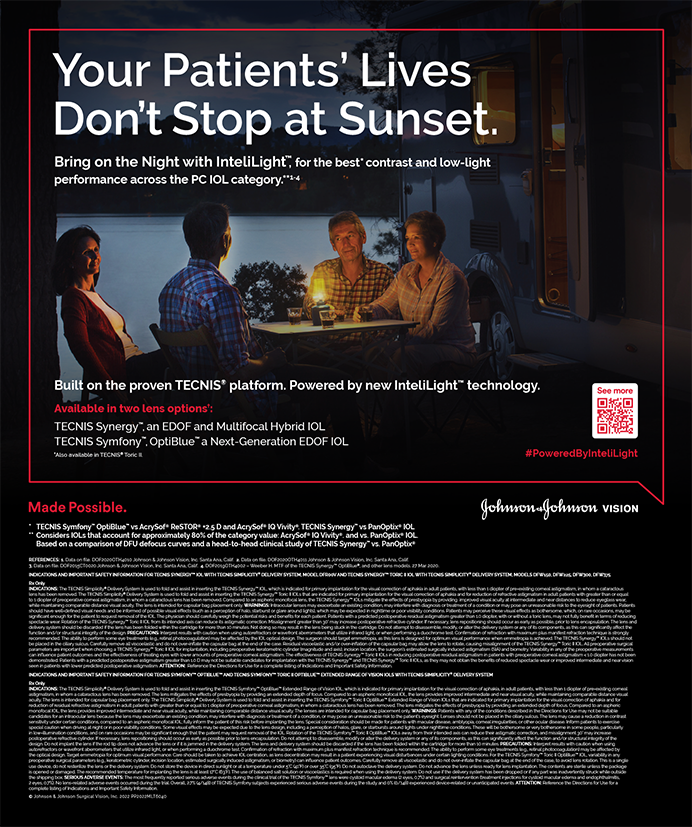Why We Said Yes to OBS
By Holly B. Hindman, MD, MPH

Office-based surgery (OBS) provides complete continuity of care from the initial consultation to surgery. Before offering OBS at my practice in Canandaigua, New York, my colleagues and I performed cataract and oculoplastic procedures at local hospitals and ambulatory surgery centers (ASCs).
The onset of the COVID-19 pandemic, however, made obtaining local surgical time increasingly difficult. High turnover and staffing shortages resulted in OR closures. A shortage of anesthesiologists forced us to become supervising providers for certified registered nurse anesthetists—a responsibility I felt beyond my scope. Our patients were traveling to other cities for surgery as a result. At that point, a transition to OBS made sense for us.
ARGUMENTS FOR OBS
Patient safety. Patient safety was paramount as we began the transition to OBS. In certain situations and for some surgeons, patients, and procedures, a hospital outpatient department or ASC may be preferable. For routine and some complex cases, however, I have come to prefer the OBS environment. Since our OBS suite opened, my colleagues and I have safely performed more than 2,000 surgeries.
The nationwide shift to OBS mirrors the transition from hospital settings to ASCs in the mid-1980s. Although initially disruptive, ASCs were soon recognized as a safe, affordable, and convenient choice for patients and physicians.1 I see the same evolution happening with OBS. More than 47,000 surgical procedures have been performed in an OBS suite across the United States.2,3
Equal accreditation standards. Our OBS suite adheres to the same safety standards as our local hospital and ASC. All three environments are accredited by The Joint Commission, Accreditation Association for Ambulatory Health Care, or the American Association of Accreditation of Ambulatory Surgery Facilities. The only difference between an OBS suite and an ASC is that the former functions under the physician’s license whereas the latter functions under a separate license. An OBS suite has the same equipment and virtually identical pre- and postoperative staging areas as any other standalone surgical center or hospital. The level of accreditation achieved by an OBS is therefore appropriate for ophthalmic surgery.
Better for patients. In addition to improved access to care, our patients experience less stress and anxiety when their surgeries are performed in a familiar environment by a team they know and trust. Recovery time is faster because there is no intravenous sedation. Many risks of eye surgery, moreover, are related to intravenous anesthesia, so OBS can be safer for patients. Fasting is not required, the waiting room is not crowded, and no surprise fees are encountered. The time required for surgery is also considerably less in our OBS suite compared to a hospital outpatient department (1 vs 3 hours).
Better for physicians and the surgical team. Our state-of-the-art OBS suite accommodates our multisubspecialty practice. Cataract procedures and many of the corneal and oculoplastic surgeries we offer are performed in this setting. We have complete control over the surgical process with 24/7 access, 365 days a year. Everything is in one place.
We choose our equipment, supplies, and surgical team. The team is invested in the surgical process, and they are empowered to manage workflows and make critical decisions in the OBS suite. Our staff is enthusiastic about the opportunity for professional growth, and we all benefit from greater efficiency.
Positive cash flow in the same year. We signed a contract with iOR Partners in October 2021, and our OBS suite was up and running in March 2022. The company facilitated our seamless transition to OBS with space planning, staff training, materials management, reimbursement support, and compliance with ASC accreditation standards. The startup costs were considerably less than they would have been for an ASC, which allowed our bottom line to be in the black the same year.
CONCLUSION
The transition to OBS is the most significant change in my career to date. The continuity of care has been unmatched, and my patients prefer OBS. In fact, they request it.
1. Stagg BC, Talwar N, Mattox C, Lee PP, Stein JD. Trends in use of ambulatory surgery centers for cataract surgery in the United States, 2001–2014. JAMA Ophthalmol. 2018;136(1):53-60.
2. Kugler LJ, Kapeles MJ, Durrie DS. Safety of office-based lens surgery: U.S. multicenter study. J Cataract Refract Surg. 2023;49(9):907-911.
3. Durrie DS, Cummings AB. Ophthalmic office-based surgery: safety outcomes from 47,714 real-world procedures. Paper presented at: AAO 2023; San Francisco, CA.
ASCs Offer Patient Safety and Rigorous Standards
By Robert J. Weinstock, MD

In a recent article for CRST, I shared that building and owning an ambulatory surgery center (ASC) is one of the most important financial decisions of my career. It has boosted my efficiency and helped me achieve a better work-life balance (click here to read the article). My main argument in favor of ASCs, however, is patient safety.
CONSIDERATIONS
Safety and rigorous standards. ASCs are bound by strict guidelines for patient monitoring, anesthesia, sterility, and environmental controls. Having regulations monitored by governing agencies ensures the safest possible surgical environment for patients. The level of oversight in an ASC setting reduces the risk of infection or complications. It adheres to mostly the same standards as a hospital setting but allows me to perform surgery in a much more efficient, streamlined fashion because the OR tends to be designed for ophthalmic surgery. In my opinion, this makes an ASC the ideal setting for surgical procedures.
In contrast, an office-based surgery (OBS) suite may lack governing oversight, proper sterilization, and patient monitoring, potentially leading to lapses in patient safety and a higher risk of complications or infection. Additionally, anesthesia needs can vary between patients. In some OBS facilities, patients receive only oral sedation. Conversely, in an ASC, anesthesia is continually monitored and can be increased as needed. Routine patient monitoring in an ASC can facilitate early detection of health issues such as arrhythmias, high blood pressure, high blood sugar, and infection. This level of vigilance is often absent in an OBS setting, where patient monitoring might be minimal. The Wild West nature of an in-office suite with no regulation or oversight and where surgeons and administrators are free to cut corners to save money scares me. Responsible operation is crucial. If an OBS suite is managed with stringent safety protocols, it can be a safe and viable option for patients. Experience has shown that without proper checks and balances, there is a propensity for human error or oversight, which can lead to failures in patient safety.
Regarding surgical complications, a well-equipped ASC is a prime setting for challenging case management. In my view, complex surgeries requiring additional instruments or anesthesia support are managed more effectively in an ASC. The absence of necessary equipment in an OBS can pose significant challenges for surgeons responding to unexpected complications during a routine case.
Patient comfort and convenience. I have built two ASCs and am considering a third. All are located within my practice footprints, with a clinic downstairs and an ASC upstairs. In effect, I perform in-office surgery, but it complies with all ASC governance and regulations. In some ways, my in-office ASC resembles an OBS setting, but it is larger and designed for high-volume throughput. There are at least 3 ORs and large pre- and postoperative areas that can handle 70 or more cases a day. Both models offer higher patient comfort and convenience because of patients’ familiarity with the location and staff compared to an external ASC. The comfort patients have with the practice and staff is invaluable. Patients who already have a rapport with their health care providers tend to feel more at ease undergoing surgery at their surgeon’s office because it maintains a sense of continuity and trust.
Financial concerns. Owning an OBS suite can be profitable in cash-pay practice models and for select private insurance patients. Challenges, however, arise concerning Medicare reimbursement. Currently, Medicare lacks a designated facility fee reimbursement pathway for this setting, creating financial hurdles. Some OBS facilities bill Medicare using alternative methods, but these approaches may fall short of the compliance and financial viability inherent in traditional billing and coding processes used by ASCs. If Medicare offered a similar reimbursement pathway for OBS suites as for ASCs along with some regulatory guidelines, I think more surgeons would consider performing surgery in this setting. This would be more compliant and financially viable than the current strategy.
Additionally, ASCs tend to have a larger footprint than in-office surgical suites. As a practice grows, surgeons must perform more surgeries in less time, necessitating additional staff and ORs. With the increased volume of cataract surgery patients, a facility with a larger footprint becomes more financially viable. In contrast, patient throughput in in-office surgical suites may lag unless there are multiple surgical suites plus a femtosecond laser room.
CONCLUSION
Patient safety and rigorous standards, patient comfort and convenience, and proven reimbursement pathways with financial viability significantly influence my preference for an ASC. OBS, however, may be a viable option in certain settings and scenarios, such as boutique and cash-pay practices or for surgeons with privileges at a distant ASC. Maintaining the highest standards of safety and care must always be the top priority for those who pursue OBS. Ultimately, the choice between an ASC and in-office surgery suite should prioritize patient well-being and surgical success.
A Balancing Act: Operating in Both Settings
By Inder Paul Singh, MD

I have been a part-owner of an ambulatory surgery center (ASC) located about 20 minutes away from my office for the past 2 years. This setting has proven ideal for managing complex cataract surgeries, patients with multiple comorbidities, and those requiring advanced anesthesia. The ASC’s infrastructure supports the need for comprehensive care with its full suite of anesthesia services and surgical tools. Meanwhile, the office-based surgery (OBS) suite is invaluable for enhancing patient care and managing costs effectively. I operate in both the ASC and OBS settings, tailoring my choice to the unique needs of each patient and the surgical team’s requirements.
OPERATING IN AN ASC
Efficiency and volume. As a part-owner of an ASC, I perform most surgeries there, benefitting from multiple ORs to ensure a swift surgical schedule. This is especially true for routine cataract surgeries, where the ASC’s efficiency is paramount.
Complex cases and anesthesia options. For complex cases requiring access to more advanced technologies and higher anesthesia levels—beyond what our OBS can offer—I also utilize the ASC. Oral sedation with 5 mg of diazepam (Valium, Roche) is typically sufficient, but for patients with pronounced surgery-related anxiety necessitating intravenous sedation, the ASC is my preferred setting due to its capabilities to manage such demands.
OPERATING IN AN OBS SUITE
Patient and staff experience. Building an OBS suite 2.5 years ago gave my practice greater autonomy over the entire patient care process. Patients appreciate the familiarity and continuity of care they receive from our staff from their first encounter through postoperative care. Additionally, staff members often demonstrate more accountability, feel more in control, and gain a deeper understanding of the patient experience in an OBS setting.
Research and scheduling flexibility. One of the additional advantages of an OBS suite is having more control over research projects. This autonomy allows us to circumvent the bureaucratic hurdles associated with obtaining approvals from external entities such as hospital outpatient departments and local Institutional Review Boards. This freedom also extends to the incorporation of new technologies and flexibility in surgical scheduling. For example, we can more readily address urgent situations such as retained lens fragments or bleb revisions in-house, which minimizes both patient anxiety and their perception of the complication’s severity. Furthermore, the flexibility of OBS scheduling enables us to perform surgeries on Friday afternoons and Saturdays based on patient needs and availability. This ensures that patients receive timely care without the typical delays associated with ASC scheduling.
Financial benefits. Financially, OBS offers several advantages, not only for cash-paying patients but also for those with Medicare Advantage and commercial insurance plans. We streamline billing by bundling OBS fees with premium IOL insertions, ensuring transparency and enhancing patient experience. This inclusivity in payment options benefits those with high-deductible plans or no coverage, and has led to an increase in our premium and refractive IOL procedures.
A MIDDLE GROUND
What sets my approach apart is a willingness to embrace a blended model. I see OBS suites and ASCs not as competitors but as complementary environments. These settings allow me to customize patient care based on individual needs and case requirements. I also maintain privileges at a local hospital, thereby prioritizing patient-centric care over rigid practice models.
As the ophthalmology landscape evolves, flexibility and adaptability in practice models are key to ensuring that patients receive the best care and outcomes. Ultimately, the patient’s well-being should be at the forefront of any decision, including the choice of surgical setting.




